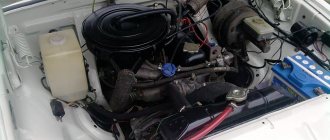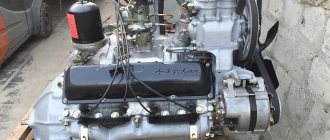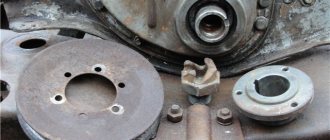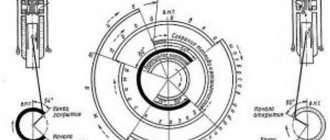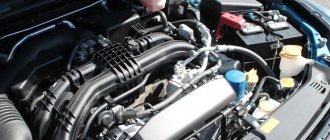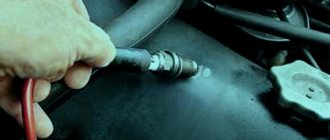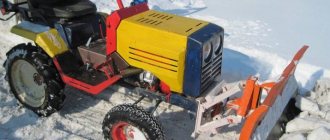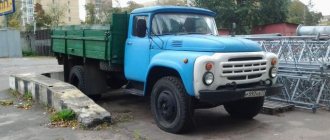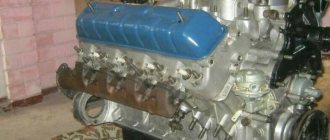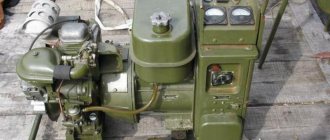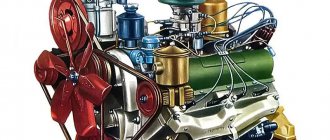One of the most legendary engines of the Soviet Union remains the ZMZ 402 engine (abbreviated as dv. 402). The manufacturer of the power unit is Zavolzhsky Motor Plant LLC, which is where the engine got its name - ZMZ 402. Another modification was the ZMZ 24D, but it did not catch on due to frequent repairs and expensive maintenance.
Story
It was developed by no less legendary designer Harry Voldemarovich Evart specifically for the Volga. This power unit was supposed to replace the outdated GAZ-21 engine. In subsequent development, many modifications were made, such as ZMZ-24D and ZMZ 4021.
This engine is also called ZMZ 24, since it was initially intended to be installed only on the 24th Volga, but as practice and history have shown, the engine has become quite widespread in other car models.
The ZMZ 24D engine had improved cooling characteristics, which reduced fuel consumption. But this series of engines was interrupted in 1972, because repairs to the power unit were too expensive.
Subsequently, VOLGA received only two power units - ZMZ 402 and ZMZ 402.1. But, as practice shows, the use of ZMZ 24 and ZMZ 24D power units has reached our time, and such engines can still be found on some 24-series cars.
Motor applicability
As already mentioned, the ZMZ 402 engine can be installed not only on the Volga passenger car, but also on a number of similar vehicles. Quite widely the ZMZ 402 was installed on UAZ. You can often find a UAZ 469 with a Volga engine. In this case, the motor was installed on the car from the manufacturer's factory. This was due to the fact that during the transition from the outdated internal combustion engine UMZ 417 to UMZ 421.
At this moment, the UAZ engine was going through hard times and the plant management decided to temporarily replace the Ulyanovsk engines with similar ones from the Zavolzhsky plant. As practice and operation have shown, the UAZ 402 was able to withstand all the required loads. But, with the release of the Ulyanovsk 421 engine, everything changed radically, and it was decided to abandon the use of ZMZ.
Another prominent representative that received these power units was Gazelle. On the first models of the light-duty GAZ truck, you can find the ZMZ 24 engine. Later, with the development and implementation of factory innovations, the 4021 engine was installed. The Gazelle with the ZMZ 402 engine was produced for quite a long time until the manufacturer began to introduce the 405 and 406 power units.
With the advent of new engine types, the situation at the GAZ plant did not change radically and the Gazelle with the 402 engine was produced before 1997. But, after replacing the body with a new model, GAZ management nevertheless decided to install only 405 and 406 engines, as well as their modifications, on new cars. Thus, the era of using the Gazelle car with the ZMZ 402 power unit has ended.
Specifications and description
The Volgov engine was considered one of the most reliable in the Union. Despite the high consumption, the 402 engine was loved by many motorists. So, let's look at the main characteristics of the ZMZ 402 engine, as well as how it works:
| Name | Characteristic |
| Manufacturer | ZMZ |
| Model | ZMZ 24, ZMZ 24D |
| Modifications | ZMZ 4021, ZMZ 4022, ZMZ 4025, ZMZ 24S |
| Motor type | Petrol |
| Injection type | Carburetor |
| Configuration | 4-cylinder in-line longitudinal internal combustion engine |
| Engine power | 95 hp |
| Number of cylinders | 4 |
| Number of valves | 8 |
| Piston diameter | 92 mm |
| Piston stroke | 92 mm |
| Cooling | Liquid |
| Block and head material | Aluminum |
| Resource | 300,000 km |
| Cylinder operating order | 1-2-4-3 |
| Ignition system | Contact or non-contact |
Permissible clearance standards
Why is valve adjustment done at all, and what happens if it is not done on time? The consequences can lead to cylinder burnout and, as a result, to expensive and time-consuming repairs of the 402 engine. In other words, this procedure allows you to maintain internal combustion engine parts in working condition.
There are several clear signs that it is time for an adjustment procedure:
- knocking of valves in the engine;
- unstable work ;
- power drop;
- increased fuel consumption.
Acceptable standards are presented below:
- 1 and 4 cylinders. For these cylinders, the tolerance values on the suction valves will be in the range of 0.40-0.45 mm, and for the exhaust valves 0.35-0.40 mm.
- 2 and 3 cylinders. Here the indicators at both the intake and exhaust will be in the range of 0.40-0.45 mm.
Adjusting the ignition timing of the ZMZ-402 engine
Page 1 of 2
The ZMZ0-402 type engine is equipped with an ignition distributor sensor (1908.3706) - non-contact, with a control pulse sensor (generator) and built-in vacuum and centrifugal ignition timing regulators.
The distribution sensor performs two functions: it sets the moment of sparking and distributes high voltage pulses among the cylinders in accordance with the order of their operation. For this purpose, a slider mounted on the shaft of the sensor-distributor is used.
A noise suppression resistor is installed in the slider.
Technical characteristics of the ignition system
What you need to know
In order to properly configure and adjust the ignition of the ZMZ 402, you need to know some nuances about the operation of the power unit. Such motors have a non-contact distributor installed, supplemented by a control signal generator and mounted advance regulators - vacuum and centrifugal (video author - smotri Vidik).
The distributor is designed to perform certain functions:
- determines the moment of spark occurrence;
- transmits high voltage signals through the cylinders of the power unit, taking into account the order of their operation.
For the correct distribution of impulses, a slider mounted on the mechanism pulley is used. The slider is equipped with a resistor and is designed to suppress interference. The switching device performs the function of opening the ignition coil winding circuit, converting control signals from the regulator into short-circuit current signals.
To correctly install the ignition on a 402 engine, it is necessary to take into account the system characteristics presented below:
- the order of operation of the cylinders is first the first, then the second, then the fourth and third;
- the rotor of the distribution element rotates counterclockwise;
- on a centrifugal device the advance angle is from 15 to 18 degrees;
- on a vacuum device this indicator is from 8 to 10 degrees;
- the play on the NW should be no more than 0.8 mm;
- the resistor resistance value should be from 5 to 8 kOhm;
- the SZ resistance parameter should vary around 4-7 kOhm;
- in the stator winding the resistance level should be no more than 0.45 and no less than 0.5 kOhm.
Disassembled distributor for ZMZ
Design features and device “3M3-402”
So, “3M3-402” is a 4-cylinder eight-valve carburetor engine with a displacement of 2.445 liters, developing a power of 100 hp. With. (modified to run on low-octane gasoline - 90 horsepower). Characteristic design features include an all-aluminum block with wet cylinder liners, as well as a lower camshaft. The motor is simple and reliable, like a Kalashnikov assault rifle.
Cylinder block. Cylinder head
The block was made by injection molding from a high-strength aluminum alloy; the pores were filled with special compounds (resins) for sealing. Some engine blocks “3M3-4022.10” and “3M3-402.10” were die cast, rather than injection molded. “Wet” cylinder liners are removable, fixed at the bottom edge. They are sealed at the bottom with copper rings, and at the top with a cylinder head gasket.
The block head was also cast from aluminum; subjected to heat treatment - hardening and aging. Valve seats made of alloy cast iron and metal-ceramic guides for their necks were pressed into it. The head height is 94.4 mm (98 mm for the 4021 engine, designed to run on 76 (80) gasoline). The collectors are located on the right side. The intake is cast from aluminum and provides for the installation of a 2-chamber carburetor. The exhaust manifold is made of cast iron, located under the intake manifold, so as to heat the intake channels. This has a positive effect on the quality of mixture formation.
The cylinder heads of the 3M3-402.10 and 3M3-4021.10 engines differ in the volume of the combustion chambers. An increase in the compression ratio of the 3M3-402.10 motor was achieved by additional milling of the lower plane of the head by 3.6 mm (that’s why the height of the 3M3-4021.10 motor head is 94.4 mm, the height of the 3M3-4021.10 motor head is 98 mm).
Between the head and the cylinder block there is a gasket made of asbestos fabric, reinforced with a metal frame and coated with graphite. The windows in the gasket under the combustion chambers and the opening of the oil channel are edged with tin. The compressed thickness of the gasket is 1.5 mm.
The volume of the combustion chamber with the valves in place and the spark plug screwed in is 74-77 cm3 for the 3M3-4021.10 engine, and 94-98 cm3 for the 3M3-4021.10 engine. The difference between the volumes of the combustion chambers of one block head should not exceed two cm3.
crank mechanism
The crankshaft is cast from magnesium cast iron, with five bearing journals. Sliding bearings (“liners”) are steel-aluminum. The front end of the shaft is sealed with a self-clamping oil seal, the rear end with an oil seal packing. The pistons are made of heat-strengthened aluminum, with temperature-regulating steel inserts, and are equipped with two compression rings and one composite oil scraper ring. Connecting rods are forged steel, I-section. The piston pins are made without fixation, i.e. floating.
The geometry according to the scheme “liner diameter 92 mm, piston stroke 92 mm” allows the engine to develop excellent torque even at low crankshaft speeds.
As already mentioned, it retained the lower timing chain (OHV) circuit of its predecessor - “3M3-24D”. The camshaft is located in the engine block on the right and is driven through a low-noise textolite or plastic gear from the crankshaft. The influence is transmitted to the valves through pushers and rods that pump rocker arms, which are located on a common axis.
Engine lubrication system
The 3M3-402 engine lubrication system is combined. The crankshaft and camshaft journals, rocker arm bushings and the upper ends of the rods are lubricated under pressure, and the cylinder walls are lubricated from splashing through special nozzles located in the connecting rod castings. The oil pump is gear-type, driven by the camshaft. The drive was made in the form of a hexagon. Oil filtration is full flow. The filter element is located on the left side of the engine.
Ignition system "3M3-402"
The ignition system is contactless. The ignition distributor is not equipped with a breaker. Instead, the system has a magnetic sensor. The signal for the coil is generated by an electronic switch and distributed to the spark plugs by the same slider in the distributor cover. The operating order of the cylinders is: 1-2-4-3.
Installation of distributor with drive
Installation of the distributor with the drive is carried out as follows (all work is carried out with the power unit running):
- Turn the distributor counterclockwise.
- Be prepared for the engine speed to increase.
- If the car owner continues to crank the engine distributor, the power unit may stop working stably.
- When the engine speed drops, you need to turn the distributor clockwise.
Similar article Do-it-yourself repair of 402 ZMZ engine
To test whether everything has been done correctly, it is recommended to sharply accelerate the car or, conversely, brake sharply and stand for a while. At the same time, the operation of the engine should be stable, and it should not stall.
Adjusting the ignition system ZMZ 402 - Do-it-yourself repair
The operation of the engine, its efficiency and reliability directly depend on the correct settings of the ignition system. In this article we will look at the design and components of the ZMZ 402 ignition system, as well as the procedure for setting the ignition timing
Ignition system elements
One of the main systems necessary for a successful engine start is the ignition system. For gasoline engines, the fundamental design of ignition systems differs very slightly - there are two types: • Contact system • Contactless system
The ignition system consists of the following components: 1. Coil 2. Distributor-spark breaker (distributor) 3. Switch 4. Spark plugs 5. Ignition switch 6. Starter 7. Additional resistance (in some cases)
How the ignition system works
For the ZMZ 402 model, this order looks like this:
1-2-4-3
The car engine is started by turning the key in the ignition switch - at this moment the charge from the battery is supplied to the starter, which begins to rotate the crankshaft, activating the distributor (via the drive). At this very moment, electric current is supplied to the coil, then through the commutator the charge is supplied to the spark distributor (distributor), which in turn distributes the current through the wires to the cylinder spark plugs.
IMPORTANT to know that the switch is a block of transistor switches that serves to control the currents that pass through the inductor.
Early ignition
One of the most common problems with the ignition system is too early an ignition timing angle - this is when, when fuel is supplied to the engine cylinder, the working mixture of gasoline and air in the combustion chamber ignites much earlier than the piston approaches top dead center. If the initial ignition timing is set too early, then problems with the vehicle's performance may occur. To avoid this, you should pay attention to signs of early ignition. And this:
• The engine does not start the first time (the crankshaft rotates in the opposite direction when starting the engine) • Unstable operation of the engine at idle • Detonation of unburned fuel (a chirping sound appears that does not disappear with increasing speed) • Carbon deposits on the spark plugs (completely unburned fuel settles on the spark plug) • Shots into the muffler (fuel burns due to misfire) • Black smoke from the muffler (fuel that is not burned in the combustion chamber burns out) • Increased fuel consumption
Late ignition
On engines with a carburetor power supply system, late ignition is the ignition of the fuel mixture at the moment when the piston has already reached top dead center or has already passed it. When the engine operates this way, fuel consumption increases, power and throttle response deteriorate. The main signs of late ignition are: • Trouble starting the engine (several attempts are needed) • Sluggish vehicle dynamics while driving (the engine stalls when the speed increases) • Spark plugs are light gray or white • Shots in the carburetor (fuel burns out in the intake manifold) ) • Engine overheating (the mixture burns out during the expansion stroke, which contributes to engine overheating)
Procedure for adjusting the ignition system
To correctly install the ignition on the ZMZ 402 engine, the following factors must be taken into account: • Engine operating order 1-2-4-3
• The rotor of the distributor rotates counterclockwise • The backlash on the spark plug should be no more than 0.8 mm • The resistance value of the resistor on the distributor should be from 5 to 8 kOhm • The resistance value on the spark plug ranges from 4 to 7 kOhm • The resistance of the stator winding varies from 0. 45kOhm to 0.5kOhm
Label matching
To begin setting the correct ignition timing, you need to turn the crankshaft to a position that indicates 5 degrees. This is done as follows - you need to set the first cylinder at top dead center (end of the compression stroke). To do this, you need to align the middle mark on the crankshaft pulley with the mark on the cylinder head.
ATTENTION. The compression stroke on the first cylinder can be set if the distributor has not been removed before - by opening its cover, the slider will stand opposite the internal contact of the wire connecting to the spark plugs of the first cylinder.
If it is not possible to determine the compression stroke in this way, then it is necessary to unscrew the spark plug from the first cylinder and plug the hole with a rag or paper. Then you should start cranking the crankshaft until the paper-shaped plug is removed with the help of air created inside the cylinder. This will be the moment of compression.
Advance angle adjustment
Next, you need to loosen the octane corrector bolt, which is located on the distributor. A 10mm wrench will come in handy here. Then the advance angle is set approximately in the middle of the scale (this will be zero). Next, using the same 10mm wrench, you need to loosen the bolt securing the octane corrector plates. The next step is to rotate the distributor housing so that both marks coincide - the red mark on the rotor head and the mark on the stator. When the housing is installed in the desired position, it is necessary to fix the distributor housing with one hand and tighten the bolt with the other.
Checking the correct installation of the ignition
The correctness of the set ignition timing is checked while the car is moving - at a speed of 50-60 km/h, the gas pedal is sharply pressed, a short-term detonation should follow (1-3 seconds). If detonation disappears after this time, then the moment was chosen correctly. You can set the ignition more accurately using a strobe light.
This short guide will help you set the ignition yourself without resorting to the help of specialists at home.
The procedure for connecting high-voltage wires UMZ 402, 4216 - A116.RU - Kazan
The procedure for connecting spark plug wires on carburetor engines GAZ, UAZ 402.
Cylinder counting always starts from the front of the car.
The procedure for connecting high-voltage wires UMZ 4216
Some difficulties may arise here due to the variety of options offered by manufacturers.
UMZ 4216 version with separate coils from the 406 motor.
The main thing is not to mix up the low-voltage coil control wires. They are almost the same length - be careful! Closer to the front there are pairs 1-4, behind there are pairs 2-3. You can swap armored wires 1 with 4, 2 with 3.
UMZ 4216 engine with ignition module.
The main thing to know is that the cylinder count starts from the front bumper of the car.
We look at the numbering of wires on the module with our eyes. There are two possible clockwise numbering options - 1234 and 1423. Therefore, be sure to check your specific module. In the photo the module number is 1234.
a116.ru
Tuning
Modifying the ZMZ 402 engine with your own hands is quite simple. Of course, many car enthusiasts who practice tuning the ZMZ 402 engine try to first change the injection system from a carburetor to a monoinjector, but in classic tuning the existing characteristics are refined. In this section we will look at what tuning can be applied to the 402 engine.
The first thing to be modified is the piston group. So, instead of a standard piston kit, a lightweight ATF from a Polish manufacturer is installed. In the same way, it is worth replacing the valves and connecting rods with lighter ones. By reducing the weight of the power unit, torque increases and engine power increases.
The next step is to groove the crankshaft and install sports-type liners. Thus, you can further reduce the weight of the motor, which will allow you to gain speed faster.
A separate stage is the modification of the injection and exhaust system. Instead of native manifolds, you can install Hungarian ones from the DDR-line company, which are designed specifically for tuning the ZMZ 402 engine and its modifications. Instead of the original K-126 carburetor, motorists usually install a monoinjector or a Zhiguli ODAZ from a VAZ 2107. This significantly reduces fuel consumption by a couple of liters. For improved air supply to the combustion chamber, a zero-resistance air filter is installed.
An integral part of the process is the modification of the ignition. So, many people know that there is contact and non-contact ignition, but the third ignition option is to install a start using a button, which does not require a key. This ignition system has become quite common when upgrading a given internal combustion engine.
In addition to the system itself, spark plugs, wires and the ignition coil are also changed. The most common company that produces tuning kits is BRW and VHI. The first is Belarus, but the second is Russia.
The tuning of the 402 engine does not end there. Also, motorists are changing the cooling system. To do this, a more advanced and lightweight aluminum radiator, pump and silicone pipes are installed instead of the standard ones. This allows for an improved cooling system that works more efficiently at high speeds and prevents the power unit from overheating.
How to determine the malfunction?
All vehicle electrical components are protected by fuses. Powerful energy consumers have relays in their design. In addition, all devices on the network are connected by wires and connectors.
Thus, when troubleshooting, you need to check the following components:
- circuit breakers;
- relay;
- wiring integrity;
- reliability of connections.
When troubleshooting, you need to check the mounting points for ground. If the lights do not light, the light bulbs may have burned out. The search for an open circuit is carried out using a multimeter. The voltage in sections of the circuit can be checked using a test light.
Maintenance
How to properly maintain your Volgov engine? It is very rare to find reliable information on the Internet about the maintenance of the ZMZ 402. In turn, technical maps from the manufacturer’s plant on proper maintenance of the motor were found. So, let’s describe how to carry out maintenance for 24:
- 1000 km: oil and oil filter change.
- 8000 km: changing oil, oil and air filters, spark plugs, high-voltage wires, fine fuel filter.
- 17,000 km: oil change, oil filter, fuel filter.
- 25,000 km: changing oil, oil and air filters, spark plugs, high-voltage wires, fine fuel filter, valve adjustment.
- 35,000 km: oil change, oil filter, fuel filter, timing belt and alternator replacement.
- 45,000 km and beyond: change the oil and oil filter. Every 20,000 km the fuel and air filters are changed and the valves are adjusted. Every 40,000 km, replace the timing belt.
Removing the distributor assembly with the oil pump drive
To carry out repair work on the distributor on a Gazelle or UAZ engine, you will need to remove it. This is done this way:
- Remove the cover along with the wires located there.
- Remove the vacuum regulator hose.
- Dismantle the fastening of the low-voltage wire.
- Remove the octane corrector fastenings. To do this, use a key of ten. And to dismantle the low-voltage wire, use a seven key.
- Finally, remove the engine distributor itself.
This task is easy and does not require special skills to complete. However, the car owner must have an understanding of the design of the motor. Installation is carried out in reverse order. It must be remembered that the distributor can only be installed in one position.
If you need to remove the oil pump with distributor, you need to do this:
- Remove the engine distributor cap. Remove high voltage wires.
- Now you need to remember how the slider is located relative to the body.
- Dismantle the vacuum hose and switch wire.
- Unscrew the two fastening nuts. The key is used for thirteen.
- Dismantle the distributor sensor and oil drive.
Remove the gasket on the engine and put in a new one if that's the problem. If the position of the engine crankshaft remains unchanged, install everything in the reverse order. If even small changes occur, then first the piston is moved to top dead center. Align the mark on the crankshaft pulley with the mark on the cylinder head. The cylinders must be closed.
Then the distributor is installed.
Choosing engine oil
In fact, only mineral oil is poured into ZMZ 402 engines. Other types of lubricants - synthetic and semi-synthetic - due to the components they contain, corrode the sealant used in the system, which is an ordinary rope impregnated with a special substance.
However, this is not always confirmed: high-quality synthetic oils can significantly increase the service life of any engine, and the 402 injector engine is no exception.
Interesting Facts
The ZMZ 402 engine has become quite widespread not only in the Union and the CIS, but also in the Baltic states, as well as Germany. Thus, the power unit was installed on such famous models as the Mercedes Benz 302 and 115.
Similar engines can be called that were installed on cars: Plymouth Valiant (1967–1976), Dodge Dart (1967–1976), Dodge Aspen and Plymouth Volaré (1976–1980), Chevrolet Nova (1967–1974), Ford Falcon (1962– 1991), Volvo 140/240 (1967–1993), Mitsubishi Debonair (1964–1986).
injector for 402 engine
| Added: Sat Aug 05, 2006 12:58 am Post subject: injector for 402 engine | Reply with quote | |
| I have a gas 31029 with a ZMZ 402 engine, I want to try installing injection instead of a carburetor, I used injectors, sensors, a fuel pump from BMW as a basis, and the control unit is homemade, but with analog control of signals, has anyone tried anything like this? |
| to come back to the beginning | to come back to the beginning | to come back to the beginning | to come back to the beginning | to come back to the beginning | https://mpsz.ru/forum/about.php Interesting thing. Now I’ll have some money, I’ll definitely buy it (a complete set, i.e. with DD and on-board computer). |
| How did you determine the problem on pot 4? Lost compression? Those. there were bullies. Or something else? |
Historical information
The first version of the engine was created for the GAZ-21 Volga by designer G.V. Evart, but due to a lot of comments, the project was reworked. Subsequently, the unit was upgraded to the ZMZ-24D standard, and the index 402 first appeared in the early 80s.
Engine assembly continued until October 2022; stable demand from consumers remained despite the appearance of the new generation ZMZ-406 with an injector.
The reason for its popularity was its simple design and the ability to be repaired in the field.
Tool for the job
The work of adjusting valve clearances requires preparation. Place tools and materials for measurements in a convenient position.
The toolkit must include:
- note styli;
- socket, open-end, ring wrenches;
- keys for removing spark plugs;
- purchased gaskets to replace used analogues;
- devices for turning the crankshaft;
- a set of negative and positive screwdrivers.
- previously unused rags.
Having the necessary material allows you to begin adjustment work.
